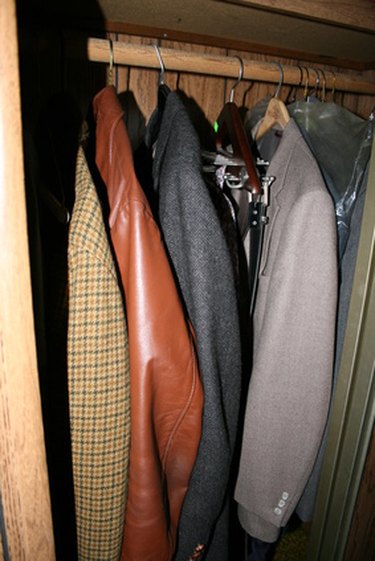Things You'll Need
Tape measure
Pry bar
Stud finder
Pencil
Level
Construction glue
Pneumatic brad nailer
Scribe
Jigsaw
Miter board
Handsaw

Cedar closets prevent moths, roaches and other bugs from eating holes in your clothing, and the closet gives your clothing an aromatic scent. It also helps prevent mildew. The cedar used to line closets is eastern red cedar, which contains an oil that is a repellent. Lining a closet with cedar planks will keep your clothes protected and smelling fresh for years.
Building a Cedar Closet
Step 1
Measure the height and width of each wall of the closet. Multiply the sum of the heights by the sum of the widths to determine the square footage you'll need to line your closet with cedar. If you wish to line the ceiling, be sure to measure that as well.
Video of the Day
Step 2
Buy enough cedar planks to cover the square footage of your closet. Although pressboard panels are available, they snag clothing and are undesirable for closets. Instead, select solid tongue-and-groove boards.
Step 3
Remove baseboard molding carefully with a pry bar, as well as any shelves or hooks in the closet.
Step 4
Use a stud finder to locate all studs in the closet. Mark each stud with a pencil. With a level, draw a plumb line from floor to ceiling along each stud.
Step 5
Begin placing a board in the back bottom corner of the closet with the groove pointed toward the floor. Place the level on top of the wood and adjust the wood until it is level. If it is not level, spread a scribe as wide as the widest gap between the floor and cedar. Lock in this width, then run the point of the scribe along the floor and let the pencil draw the slope. Use a jigsaw to cut along this line.
Step 6
Apply a zigzag pattern of construction glue to the back of the board. Press the board in place at the center so the glue can spread outward evenly behind the board.
Step 7
Nail through the tongue of the board over each stud line with a pneumatic brad nailer at a 45-degree angle pointed down, in order to leave room for the next groove to fit over the tongue. Begin on one side and work horizontally, using a level to keep the board level.
Step 8
Repeat Steps 5 through 7 until the bottom row of the back wall is lined with cedar. Use a handsaw and miter box to cut the wood to fit.
Step 9
Use a handsaw and miter box to cut the wood to fit the next row. Stagger the wood seams for a more cosmetic effect.
Step 10
Apply adhesive to the back of the cedar in a zigzag pattern. Fit the groove of the board onto the tongue of the row below, then press to wall in the center of the board. Check the level and adjust to make it level. Nail just as you did in Step 7. Continue Steps 9 and 10 until the back wall is completely lined with cedar.
Step 11
Measure the height of the space where each end of the board will go in the top row. Subtract 1/8 inch and use a pencil to mark the height on the board, so that you will cut off the tongue side. Use a jigsaw to cut along this line. Repeat Step 10 to finish the top row.
Step 12
Repeat Steps 5 through 11 on the side walls and ceiling (if desired), making sure the back edge of the side boards cover the cut ends of the cedar boards on back wall. Also line up the side wall boards with the rows on the back wall so the corners do not appear crooked.
Tip
When the scent fades after a few years, a light sanding will rejuvenate the cedar to its original aromatic state.
Warning
Before applying adhesive, always dry-fit the board to make sure it will fit where you plan on putting it.
Video of the Day